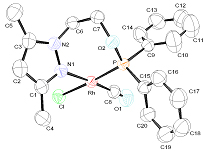Chemistry

Characterization of two new ligands and their reactivity towards Rh (I)
Ligands are either atoms, ions, or molecules that bond to a central metal, generally involving formal donation of one or more of its electrons. In this research, scientists have synthesized and characterized two new ligands N-pirazole and P-phosfinite and studied their reactivity towards Rh (I), obtaining new crystalline structures by X-ray diffraction.
References
"New N-pyrazole, P-phosphinite hybrid ligands and corresponding Rh(I) complexes: X-ray crystal structures of complexes with [Rh, N, P-phosphinite, Cl, (CO)] core". Munoz, S; Pons, J; Solans, X; Font-Bardia, M; Ros, J. JOURNAL OF ORGANOMETALLIC CHEMISTRY, 693 (12): 2132-2138 JUN 1 2008.
During the last century the interest for the coordination and the organometallic chemistry has increased impressively. The potential applicability of complexes where the metal is coordinated to organic ligands by a heteroatom (N, O, S, P, etc) has focused the interest of many laboratories [i, ii, iii]. In particular, ligands with two or more different heteroatoms have been studied for its potential hemilabile properties [iv, v]. Our group has previously reported several functionalized thioether-, amino- and phosphino- containing pyrazole ligands [vi, vii, viii ] and we have studied their reaction with Pd(II), Pt(II) and Rh(I).
During the last years the phosphinite group [P(OR)R’2] has experimented an important attention in the coordination chemistry for its capability to modulate electronic and steric properties against phosphines [PR3 ] and many utilities have been investigated [ix]. Following the interest of hybrid ligands, our group has recently published a paper with the synthesis and characterisation of two N-pyrazole, P-phosphinite ligands and its reaction towards Ru(II) [x].

In this paper, two new N-pyrazole, P-phosphinite hybrid ligands, (Figure 1) have been synthesised and characterised. The reaction of these ligands towards Rh(I) complex has been studied and complexes with formula [RhCl(CO)L] have been obtained (figure 2). All complexes are fully characterised by analytical and spectroscopic methods and the resolution of two crystalline structures by single crystal X-ray diffraction methods are also presented. In these complexes, the ligands are coordinated via κ2 (N,P) to Rh(I), forming metallocycles of seven or eight members and finish its coordination with a carbonyl monoxide (CO) and a trans-chlorine to phosphorus atom. Weak intermolecular interactions are also detected and studied. NMR studies of complexes in solution corroborate the solid data.
i J. L. Sessler, E. Tomat, Acc. Chem. Res. 40 (2007) 371.
ii V. Marin, E. Holder, R. Hoogenboom, U. S. Schubert, Chem. Soc. Rev. 36 (2007) 618.
iii B. Breit, Angew. Chem., Int. Ed. 44 (2005) 6816.
iv M. Bassetti, Eur. J. Inorg. Chem. (2006) 4473.
v P. Braunstein, F. Naud, Angew. Chem., Int. Ed. 40 (2001) 680.
vi A. de León, J. Pons, J. García-Antón, X. Solans, M. Font-Bardía, J. Ros, Inorg. Chim. Acta 360 (2007) 2071.
vii A. Rimola, M. Sodupe, J. Ros, J. Pons, Eur. J. Inorg. Chem. (2006) 447.
viii A. Pañella, J. Pons, X. Solans, M. Font-Bardía, J. Ros, Eur. J. Inorg. Chem. (2006) 1678.
ix F. Agbossou-Niedercorn, I. Suisse, Coord. Chem. Rev. 242 (2003) 145.
x R. Tribó, S. Muñoz, J. Pons, R. Yáñez, A. Alvarez-Larena, J. F. Piniella, J. Ros, J. Organomet. Chem. 690 (2005) 4072.
Sergio Muñoza, Josefina Ponsa, Xavier Solansb Mercè Font-Bardiab i Josep Rosa
a)Departament de Química, Unitat de Química Inorgànica Universitat Autònoma de Barcelona b) Departament de Cristal·lografia, Mineralogia i Dipòsits Minerals Universitat de Barcelona
2025 Universitat Autònoma de Barcelona
B.11870-2012 ISSN: 2014-6388
